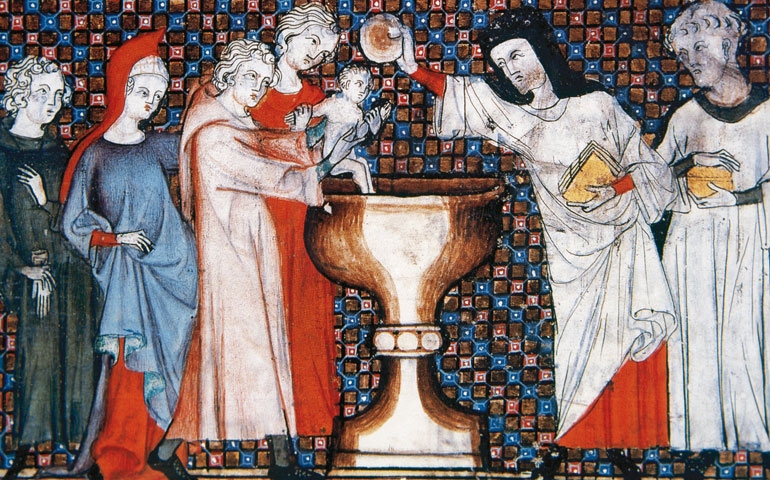A Second Look: Saved Through Water
1st Sunday of Lent (B)
click here for readings
The prayer and fasting we undertake during Lent is meant to emulate Jesus’ forty days fasting in the desert before the start of His public ministry. So it makes sense that on the first Sunday of Lent our gospel reading would tell of Jesus’ time in the desert where He was tempted by Satan. But we may be surprised to hear in our first reading about Noah and the flood, and God setting a rainbow in the sky as a sign of His covenant. When we think of Lent, we don’t often think of rainbows. But maybe we should. The rainbow is God’s sign of new life after death. This is very much what Lent is about.
Suffering & Salvation
This past Wednesday evening (Ash Wednesday) the students putting on our after dinner program asked a very important question: what is the difference between suffering and penance? In the discussion that followed, students pointed out that suffering is something that happens to us and it is unavoidable. Everyone suffers. But penance is something we do. It can turn our suffering into salvation.
Christ suffered for us, even to the point of dying on a cross. But He did not suffer for no reason. As St. Peter points out in this Sunday’s second reading, “Christ suffered for sins once, the righteous for the sake of the unrighteous, that He might lead you to God” (1 Pt 3:18). We take on penance not to punish ourselves, but to lead us closer to God. This is true of any suffering we are called to endure in life. The key is to suffer with Christ.
Baptism
Uniting ourselves with Christ’s suffering, death and resurrection is what the sacrament of baptism is all about. Like rainbows, we might not associate baptism with Lent. But Lent has its origins in the period of preparation catechumens (those seeking baptism) would undergo in the weeks leading up to their baptism at Easter. Still today, Lent is a time of purification and enlightenment for catechumens going through the Rite of Christian Initiation of Adults (RCIA), marked by public liturgical rites. For those already baptized, it is reminder of the ongoing need for repentance and conversion.
Given this context, it makes sense that the first reading from this Sunday’s Mass (Gen 9:8-15) is about Noah and the flood, and specifically, the rainbow. With this sign, God promises never again to destroy the earth by water. Water is an amazing thing. It can bring death, as in a flood. But water is also necessary for life. We use water to clean and purify.
Saved Through Water
When God destroyed the world by water in Noah’s day, it was destructive, but also cleansing. The story of the flood begins by noting the great wickedness of mankind on earth (Gen 6:5). The purpose of the flood was to purify the earth of this corruption. Noah and his family were righteous and so were spared, and from them new life would begin.
This is why St. Peter speaks of not of the world being destroyed by water, but of Noah and his family being “saved through water.” He says, “This prefigured baptism, which saves you now” (1 Pt 3:20). God has promised not to destroy the world through water. So He uses water instead to bring new life. Just as in the days of Noah, the waters of baptism wash over us like a flood, cleansing us of all that is evil while preserving all that is good.
Water can bring both life and death. And so the Catechism teaches that the water of baptism “symbolizes the catechumen’s burial into Christ’s death, from which he rises up by resurrection with Him, as a new creature” (CCC 1214).
Death & Resurrection
Baptism teaches us that there is no life without death. There is no dawn without night. There is no Easter without Lent. We cannot rise with Christ unless we first die to self. And that’s hard. Putting God’s will and others’ needs before our own ego is hard. We have to be willing to suffer that hardship. But we don’t have to suffer it alone.
This is the point of St. Peter’s reminder about baptism. He wrote his letter to Christians in the midst of persecution. They were suffering for their faith, and many no doubt were wondering if it was worth it. St. Peter exhorts them to not be afraid of suffering. He reminds them that Christ also suffered, and His suffering saved many. Further on in his letter, he even says that we should rejoice when we share in Christ’s sufferings (1 Pt 4:13).
Suffering may not seem like cause for rejoicing — and it isn’t, on a natural level. But as Christians, we are plugged in to a supernatural reality. St. Paul says that we who have been baptized in Christ “have put on Christ” (Gal 3:27), so that we can say with the Apostle that “it is no longer I who live but Christ who lives within me” (Gal 2:20).
In baptism we are reborn as members of the Body of Christ. So that when we suffer, it is the Body of Christ who suffers. And the suffering of Christ, born out of love for us, brings salvation, not only for us but for others. This is what Christians mean when they say, “offer it up.” This is why we can rejoice in our suffering. And this is the difference between mere suffering and penance. The difference is Jesus Christ.
A Time of Joy
Lent is a time of penance, suffering and mortification. But it should also be a time of great joy, as we die to sin and death so that we may rise with Christ to new life.

